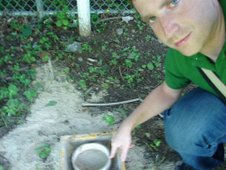

The Brooklyn Paper
This story was reported by Matthew Lysiak for The Brooklyn Paper and by Associated Press reporters including Verena Dobnik.
A rare tornado ripped through Bay Ridge early Wednesday, uprooting trees, damaging homes and cars, and knocking out subway service during the morning rush hour.
The related storm whipped through the rest of Brooklyn, wreaking havok.
Residents were awakened between 5:30 and 6 am by the sound of car alarms, thunder, and trees crashing down to the ground as the powerful wind and rain storm attacked.
Tornadoes have hit New York City before, but not often. The National Weather Service had records of at least five, but none was as strong as Wednesday’s twister, which had winds as high as 135 mph.
The service had only sketchy details on the last reported tornado sighting in Brooklyn, in 1889.
“It’s a once-in-a-lifetime event,” said Jeffrey Tongue, a Weather Service meteorologist.
In Bay Ridge, the worst area may have been Ovington Avenue between Ridge Boulevard and Third Avenue. Some of trees on the block were ripped out of the ground, while the few trees left standing had large limbs pulled off.
Spectators in awe of nature’s wrath crowded emergency crews. Others gathered at the busy intersection of 68th Street and Third Avenue, taking pictures of the a large tree that uprooted an entire square of sidewalk.
Few streets escaped damage.
“I have lived here for 38 years and this is one of the worst I remember,” said resident Henry Putko. “The storm came through and just ripped up everything in its path.”
The roads weren’t the only things affected. The R Train was temporarily shut down, as were several subways lines in Downtown Brooklyn.
“One big rain and it all falls apart,” said Ruby Russell, 64, as she sat waiting on a train in Brooklyn. She had been trying to get to Manhattan for three hours.
State Sen. Marty Golden asked Gov. Spitzer to proclaim Bay Ridge a disaster area because of the weather and, more specifically, the “tornado and flash flooding that ripped through the area.”
“I have witnessed the significant damage caused by the winds and flash flooding which requires a rapid and coordinated response,” Golden said. “It’s imperative that the governor acts quickly and does the right thing for these communities so that the people have access to all resources and financial assistance.”
One man standing by his car surveyed the damage done by a falling tree while waiting for the fire trucks to get to his street.
“This kind of wind looks like it was a tornado,” said Anjan Rau, as his car sat smothered by a giant branch. “I hope my insurance is going to cover this.”
There were no immediate reports of injuries, and Community Board 10 was out on the streets getting estimates of the damage, according to the office.
Keeping the subways dry is a challenge, even in regular weather. On an average day, hundreds of MTA pumps remove 13 million gallons of water from the system.
Public officials called for improvements in the drainage system after a similar rain-related shutdown in 1999, and the MTA made some changes after another round of paralyzing tunnel floods in 2004, when the remnants of Hurricane Frances washed out the subways for hours.
The city’s sewer and stormwater drains can handle steady rain, “but when it comes to these very intense, high inch-count rain events, over a short period of time, it is very difficult,” said Michael Saucier, a spokesman for the city’s Department of Environmental Protection.
DEP Commissioner Emily Lloyd said the city is spending $300-million per year upgrading its piping systems and has been gradually building a more robust stormwater drainage system to replace the old combined sewers that handled wastewater and rain.

No comments:
Post a Comment